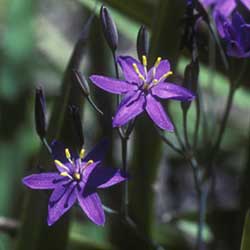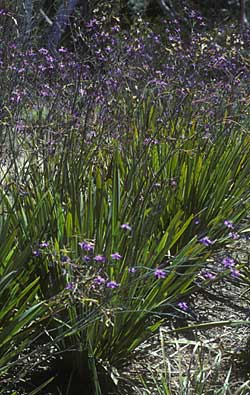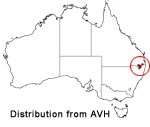Thelionema grande
 |
 |
Tufted Granite Lily
Thelionema grande (C.T.White) R.J.F.Hend.
Thelionema grande (synonym Stypandra grandis), family Hemerocallidaceae, also known as the Tufted Granite Lily, is a highly attractive perennial plant. This lily occurs naturally on granite rock outcrops and the sandy soils of north-eastern New South Wales and south-eastern Queensland. The species is usually found in dry sclerophyll forests, woodlands or heathlands at altitudes greater than 800 metres.
 The
Tufted Granite Lily grows to 125 cm tall, forming in dense clumps. Thelionema
grande has several features that make it desirable for the home garden.
Fresh shoots have a distinctive bluish colour, making the foliage of the plant
quite attractive. Flowers are produced in spring to early summer and are borne
on erect branched stems. The flowers are large, deep blue or rarely white, with
distinctive yellow anthers. The peak flowering period is from November to early
December, with fruits produced shortly afterwards in the summer months.
The
Tufted Granite Lily grows to 125 cm tall, forming in dense clumps. Thelionema
grande has several features that make it desirable for the home garden.
Fresh shoots have a distinctive bluish colour, making the foliage of the plant
quite attractive. Flowers are produced in spring to early summer and are borne
on erect branched stems. The flowers are large, deep blue or rarely white, with
distinctive yellow anthers. The peak flowering period is from November to early
December, with fruits produced shortly afterwards in the summer months.
This lily prefers an open position in full sun and is moderately frost tolerant. It does best in sandy soils that contain some organic matter and have good drainage. Thelionema grande could easily be used as an attractive alternative to Dianella, Lomandra and would not look out of place planted amongst exotic species such as Iris. It is a hardy plant that does not have any major pests or diseases. Provided that drainage is good, plants will respond to the use of small amounts of native plant fertiliser.
Thelionema grande requires little work to maintain a clean and attractive appearance. The dead brown leaves can be removed by pulling them out at the base to create a clean appearance. Alternatively cutting the plant back to remove the spent leaves can also create a desirable appearance. This plant can also be transplanted; this is best done in the cooler months of autumn and winter.
While the species produces ample seed, they have a low germination rate and are difficult to propagate. Treatment with smoke may improve results though trials to date have not been encouraging. The best method of propagation is by the division of plants, best done in winter when growth has slowed. Plants the size of a 15 cm pot or larger are the best candidates for division. Once divided, plants should be monitored for signs of new growth before hardening off and eventually planting out. A good quality potting mix that includes one-part river sand is ideal. Like many other plants, Thelionema needs to be kept moist but not damp until the plant has established.
This plant has a lot of potential for use in the home garden.
Text by Owen Harrod (2004 Student Botanical Intern)
Derivation of the name: Thelionema grandeThelionema – from the Greek thelion meaning a little teat or nipple and nema meaning a thread. This refers to the stamen filaments that are papillary hairy except at the tip and the base. grande – from the Latin grandis meaning large, great, grand or tall. |
References
ANBG (Australian National Botanic Gardens) (1999) In flower this week. Available at: http://www.anbg.gov.au/iftw.old/iftw_99_12_03.html [Accessed 2004, February].
Harden G. J. (ed.) (1990) Flora of New South Wales, NSW University Press, Kensington.
Henderson, R.J.F. (1985) Thelionema, a new genus of the Phormiaceae from Australia, Austrobaileya 2(2): 109-111.
NSW NPWS (N.S.W. National Parks and Wildlife Service) (2002) Draft plan of management, Stony Batter Creek Nature Reserve. Available at: http://www.nationalparks.nsw.gov.au/PDFs/pom_draft_stony_batter.pdf [Accessed 2004, February].
Ralph, M. (2003) Growing native plants from seed for revegetation, tree planting and direct seeding, 2nd edition. Murray Ralph/Bushland Horticulture, Fitzroy, Vic.
![An Australian Government Initiative [logo]](/images/austgovt_brown_90px.gif)

